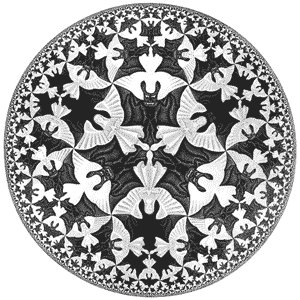Unconscious
Why Our Dark Sides Make Us Better Writers
In writing, playing it safe can backfire.
Posted February 12, 2013

Do you see angels or demons?
If you’ve ever had to get up in front of a group of strangers and speak, you’re familiar with the fear that you’re going to embarrass yourself while all eyes are on you. Worse, all that attention seems to magnify your every quirk, and your flubs can feel like they overshadow what you get right.
Even when we’re not on stage, stress makes us flounder. It’s easy to live our lives according to our values and beliefs when everything is going right; it’s a lot harder when we’re under pressure and in the spotlight.
Carl Jung named the face we present to the world, the public façade we use to hide things we don’t like about ourselves the persona. The flipside of the persona is the shadow, which is like a three-dimensional version of our physical shadows, packed full of things we’re trying to hide, sometimes even from ourselves.
To become whole, each of us needs to individuate, or integrate, all of our archetypal parts into a cohesive whole. That includes the persona and the shadow.
In any story, the mark of a good villain is his (or her) ability to force your hero into the proverbial spotlight, where he will find ways to magnify and criticize the things your hero would most like to hide.
The Dark and Light Sides of the Shadow
Some modern Jungian psychologists believe that in spite of its function as a reservoir for human darkness—or perhaps because of this—the shadow is the seat of creativity.
Author Ralph Keyes argues that most people never publish because they’re not willing to find and face their shadows. Rather than acknowledge our fears about what we might find inside ourselves, we project the anxiety onto others and obsess about what they will think. Good writers push past the fear, Keyes says, in spite of the repercussions: “One reason so many good writers have such tattered personal lives is that they write as if they have no one to protect. Lucky for readers, not so lucky for writers.”
Recognizing Your Own Shadow
Since the shadow is, by definition, upsetting to acknowledge, we shove our awareness of it down into the unconscious. That means that the only way to truly know what’s in your shadow is to think about the things that infuriate you, disgust you, and horrify you more than anything else. If cruelty just makes you sick, Jung would say that cruelty is in your shadow.
Does that secretly mean you’re a cruel person? No, but it does mean you'll have an awfully hard time accepting that you really are capable of the kind of cruelty that makes you so sick. Many, many people are riveted by true crime and serial killer stories because they give us a way to indulge the shadow without actually acknowledging that the shadow is part of us.
If you’re reacting to the last two paragraphs with skepticism or irritation, you’ve found the feeling that means you’ve touched your shadow. If you can’t face it, Betsy Lerner says, “you[‘ll] think you can’t write, but the truth is you can’t tell. Writing is nothing if not breaking the silence.”
Finding Your Characters’ Shadows
Good characters have shadows, just like you do, and your characters’ shadows should repel them as much as yours do you. What that means is that channeling your own shadow through your characters will help you create the kinds of villains that have made writers famous. If Stephen King had hidden from his shadow, The Shining would never have been written. The same goes for lots of other famous stories. Dante’s Inferno. Bret Easton Ellis' American Psycho. The Exorcist. Dr. Jekyll and Mr. Hyde. Frankenstein. Dracula. Don't be afraid to go spelunking in your shadow for some truly great villainous material.
If you really let yourself do this, you may start to worry that your imagination is a scary place. But remember: writing about it is not the same as doing it.
For more information on creating great villains in your stories, check out The Writer's Guide to Psychology: How to Write Accurately About Psychological Disorders, Clinical Treatment and Human Behavior. More information is available on the book's website.
© 2013 Carolyn Kaufman, PsyD ♦ Psychology for Writers on Psychology Today




